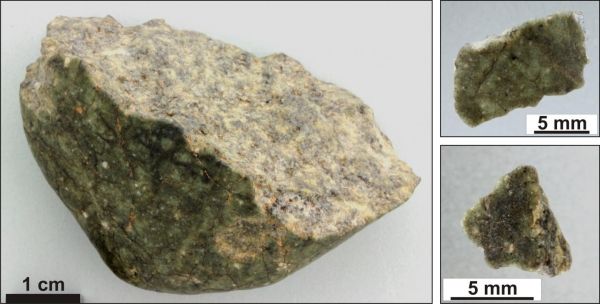A team of European researchers discovered a new high-pressure mineral in the lunar meteorite Oued Awlitis 001, named donwilhelmsite [CaAl4Si2O11]. The team around Jörg Fritz from the Zentrum für Rieskrater und Impaktforschung Nördlingen, Germany and colleagues at the German Research Centre for Geoscience GFZ in Potsdam, Museum für Naturkunde Berlin, Natural History Museum Vienna, Institute of Physics of the Czech Academy of Science, Natural History Museum Oslo, University of Manchester, and Deutsches Zentrum für Luft und Raumfahrt Berlin published their findings in the scientific journal “American Mineralogist”.
Besides the about 382 kilograms of rocks and soils collected by the Apollo and Luna missions, lunar meteorites allow valuable insights into the formation of the Moon. They are ejected by impacts onto the lunar surface and subsequently delivered to Earth.
Some of these meteorites experienced particularly high temperatures and pressures. The extreme physical conditions often led to shock melting of microscopic areas within these meteorites. These shocked areas are of great relevance as they mirror pressure and temperature regimes similar to those prevailing in the Earth’s mantle. Therefore, the microscopic shock melt areas are natural crucibles hosting minerals that are otherwise naturally inaccessible at the Earth’s surface. Minerals like wadsleyite, ringwoodite, and bridgmanite, constitute large parts of the Earth’s mantle. Theses crystals were synthesized in high-pressure laboratory experiments. As natural minerals they were first described and named based on their occurrences in meteorites.
Read more at GFZ Geoforschungszentrum Potsdam, Helmholtz Centre
Image: Fragments of the lunar meteorite Oued Awlitis 001 acquired by the NHM Vienna and used for the scientific analyses. The largest specimen is on display at the NHM Vienna. (Credit: © NHM Vienna, Ludovic Ferrière)


